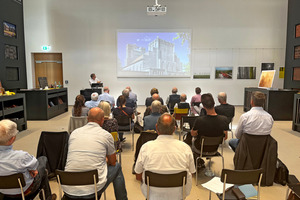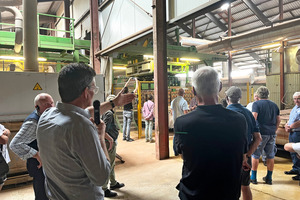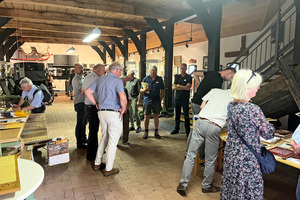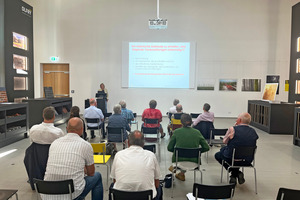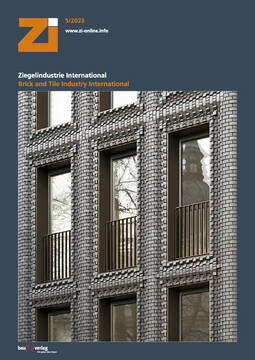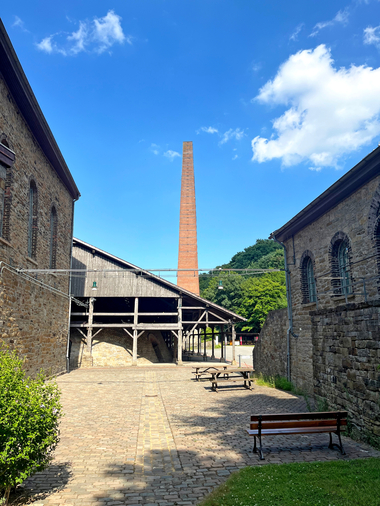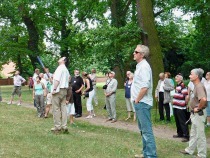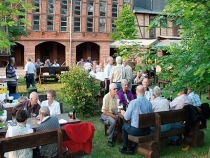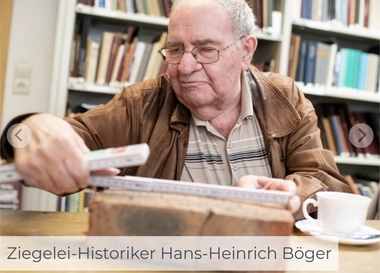Brickworks museums meet for the second time at Olfry Ziegelwerke in Vechta, Germany
Brick architecture in Germany in the 20th and 21st centuries was the focus of the 26th meeting of the brickworks museums. A small but very lively group of around 25 participants gathered in the rooms of the Olfry brickworks in Vechta in Lower Saxony to attend the conference on 26 and 27 June.
The preceding Sunday, 25 June, was dedicated to a preliminary programme. The participants met for a guided tour of the Museumsdorf Cloppenburg, which had the theme of building with bricks. In the evening, there was a rustic dinner in the clay pit of the Olfry brickworks together with host Georg Wilhelm von Frydag, who headed the Olfry works from 1969 to the end of 2014.
Day 1: Of detached houses, brick architecture and museums in rural areas
The lecture programme of the conference took place in the Olfry exhibition hall. Mr Frydag opened the lecture programme, welcomed the participants and thanked the organisers. He expressed his pleasure that the conference was again held at Olfry. In 2005, Olfry brickworks hosted the conference series for the first time, which was then held for the twelfth time.
The lecture programme began with a highlight. Dr. Michael Schimek, deputy museum director of the Cloppenburg Museum Village, analysed in his lecture “4 Walls. The dream of owning your own home - yesterday, today and tomorrow”, the conditions of living in a single-family house. The attractiveness of living in a single-family house initially consisted in its similarity to aristocratic forms of housing and its distinction from apartment buildings, which were associated with misery at the time. From the 1950s onwards, the promotion of single-family ownership in the FRG was a political goal in order to promote state ties and family and gender norms that were valid at the time. In view of the high costs, high expenditure of resources, demographic development and lack of infrastructure, the social question arises as to whether and to what extent the construction of single-family houses is still desirable today. The lecture was followed by a controversial discussion about past and present forms of housing and the future of the single-family house. Schimek emphasised that this must be the subject of a social debate.
Afterwards, plant manager Frank Kordes gave a tour of the Olfry brickworks. The participants were able to see all production steps - from the clay pit to the clay store, feeder, shaping, drying, firing, quality control and packaging.
After a lunch snack, the lecture programme continued. Diemar Osses, museum director of the LWL Museum Zeche Hannover in Bochum, presented brick architecture in the Ruhr region. This is only known in rare cases, which does not correspond to its importance and ubiquity, especially in industrial construction and public buildings. As a striking example, Osses cited the Malakoff towers, whose appearance is based on castle romanticism. This historicism was also intended for investor communication, among other things. Other examples Osses gave were related to neo-Gothic, Expressionism and New Objectivity.
Stephan Horschitz, research assistant at the Schlossmuseum Jever of the Kulturverbund Friesland, addressed the question of how cultural diversity can be preserved in rural areas. Small museums in rural areas in particular are confronted with a demographically induced loss of members in the sponsoring associations and declining visitor numbers. Competition with urban locations that attract tourists also plays an important role. He named several conditions for an improvement; among others, good transport connections are essential.
At the end of the lecture programme of the first day, the brick museums reported on news from their thematic areas and houses. Afterwards, Frydag invited the participants to his private brickworks museum at Gut Daren. There, in addition to many testimonies from the history of brickmaking, realia, documents and pictures, they could also view the extensive archive, which contains archives of his own and other companies, technical literature and even a complete collection of the Zi. At the end of the day, the host invited the guests to dinner and drinks in the administration building of the brickworks.
Day 2: Of brick expressionism, naming of prizes and the pitfalls of the Ahlhorn signal box
The programme of the last day began with a lecture by Willi Kulke, director of the LWL Brickworks Museum Lage on brick expressionism. In April 2024, an exhibition at the Brickworks Museum Lage will be dedicated to the topic. In the lecture, Kulke discussed the thesis that Expressionism in architecture was not a style but rather an epoch. He discussed important architects of the time such as Mendelsohn, Fritz Höger and Alfred Fischer. He also spoke about the types of buildings affected, such as public buildings and churches, as well as examples, such as Oberhausen’s main railway station and the town hall.
Jens Kallfelz, Managing Director of the Kopfkunst communications agency in Münster, presented the Prize for Brick Architecture, formerly the Fritz Höger Prize, now the Erich Mendelsohn Prize, explained the motives and background for the choice of name and described the debate about the renaming and the subsequent naming process.
Kerstin Stölken from the Monument Service gave a presentation on the renovation of the Ahlhorn signal box. The Monument Service pursues the goal of preserving the stock of historic buildings in the entire Weser-Ems region. The signal box with its water tower and clinker brick façade is on the one hand an architectural and technical monument and on the other hand the headquarters of the Monument Service. Stölken presented the history of the signal box and especially the renovation and the technical challenges, in particular repeated measures against the high moisture penetration of the brick walls.
At the end of the conference, Lisa Egeri, deputy director of the LWL Museum Ziegelei Lage, presented measures and plans to revive the conference series. The consequences of the Corona pandemic on visitor numbers and alignment structures are not yet over. Among other things, partners are needed both for the organisation and to cover the costs. Although there is still work to be done, the organisers expressed the hope that the brickworks museums’ conferences will soon reach the same audience as before the Corona pandemic. This was followed by a lively and optimstic discussion about the future of the conference series and upcoming venues.
The next meeting of the brickworks museums will take place in 2024 in the Mildenberg Brickworks Park near Zehdenick in Brandenburg.

